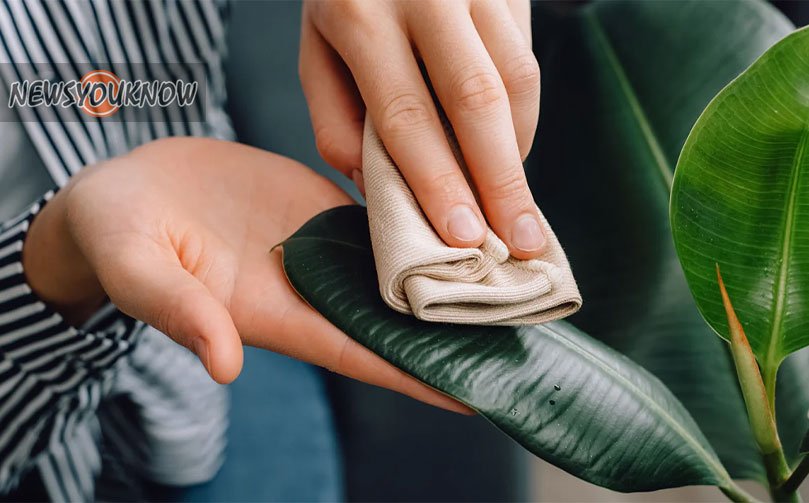Keeping the leaves of household and outdoor plants clean is an important part of caring for their health. Dust, dirt, and other debris can accumulate on the surface of leaves, blocking sunlight and air flow needed for photosynthesis and respiration. One particularly challenging contaminant that sometimes ends up on plants is paint. Paint on plant leaves can cause damage, so it’s important to know how to safely remove it.
Importance of maintaining clean plant leaves
Clean plant leaves are critical for a plant’s growth and survival. When leaves are kept free of paint, dust, dirt, and other contaminants, the plant can effectively carry out photosynthesis by absorbing light and carbon dioxide. Photosynthesis allows plants to produce the nutrients and energy they need to grow. Blocked or damaged leaves reduce a plant’s photosynthetic capabilities.
Keeping leaves clean also allows for proper air flow around the leaves. Good air circulation brings in carbon dioxide that is essential for photosynthesis and allows oxygen to flow out as a byproduct. Proper gas exchange keeps plants healthy. Paint or other debris blocks these gas exchange processes, starving plants of required CO2.
Furthermore, keeping leaves clean improves the overall appearance and aesthetics of plants and prevents disease. So for the ongoing health of household and outdoor plants, it’s essential to understand how to gently remove paint from leaves and properly care for plants.
Understanding the Risks
Impact of paint on plant health
Paint is damaging to plant leaves because it forms an impermeable barrier over the surface, blocking light, air, and moisture from reaching the leaf. Paint essentially suffocates leaves by disrupting normal plant processes.
With less light coming in, the plant’s ability to photosynthesize drops drastically, impeding energy production and growth. The coating of paint also traps more heat around the affected area of the leaf. This excessive heat buildup can burn and damage leaves.
In addition, painted leaves cannot transpire water vapor out or take in carbon dioxide properly due to the barrier over their pores. This leads to a harmful buildup inside the plant, while starved of the CO2 needed for photosynthesis.
Common issues faced by plants due to paint
Some common problems faced by plants with painted leaves include:
- Reduced growth rate and stunted development
- Wilting, shriveling, or desiccation of painted leaves
- Burns, lesions, and necrosis (tissue death) on affected leaves
- Detachment of painted leaves from the main plant
- Abnormal coloring (chlorosis) of leaves
- Increased vulnerability to pests and diseases
- Poor flowering and reduced fruit/vegetable yields
- Plant stress, shock, or even death in severe cases
The severity of issues depends on the amount of foliage painted but can quickly escalate if not remedied. So it’s critical to promptly and properly treat painted areas on plant leaves.
Identifying Paint Types
Differentiating between water-based and oil-based paints
The first step in approaching paint removal from plant leaves is to correctly identify whether water- or oil-based paint is involved. This determines the solvent needed to break down the paint safely.
Water-based paints use water as the solvent and main ingredient. They will feel moist or sticky to the touch even when dry. Water-based paints are generally safer, simpler to remove, and better for the environment compared to oil-based varieties.
Examples of water-based paints are:
- Latex paint
- Acrylic paint
- Watercolors
- Poster paints
- Washable tempera paint
Oil-based paints use organic solvents as their medium. They feel smooth and hardened when dry. Oil-based paints can be more difficult to remove and require stronger chemical solvents to break down.
Types of oil-based paint include:
- Alkyd paints
- Enamel paints
- Oil paints
- Shellac primer/varnish
Knowing the impact of each type on plants
Water-based paints generally pose less of a health risk and are gentler on plant leaves compared to oil-based. The natural components in water-based paints make them more compatible with living plant tissue.
Oil-based paints contain more toxic solvents and substances like heavy metals that can critically damage plants. However, regardless of paint type, leaving any paint to remain on and dry out plant leaves will eventually compromise their health and functions.
So both paint types need dedicated removal efforts tailored to the solvent properties required to break them down. The good news is water-based paints can usually be removed with non-toxic substances easily found at home.
Assessing Plant Sensitivity
Recognizing plants more susceptible to paint damage
Although no plant benefits from having painted leaves, some specimens and species are more vulnerable to lasting damage compared to others. Factors that determine sensitivity levels include:
Age of plant: Younger seedlings are more fragile than mature, established plants. Paint drying or building up on newly sprouted leaves often causes irrecoverable harm.
Leaf properties: Plants with thin, delicate foliage like ferns are more prone to paint damage versus succulents or palms with durable, waxy leaves. Soft, permeable leaves absorb more paint.
Growth habits: Slow-growing trees, shrubs, and perennials don’t recover as quickly from painted leaves versus quick-growing annuals and resilient weeds. Rapid growers can generate new unpainted foliage faster.
Native species and cultivars: Exotic ornamentals bred for specific desirable traits tend to be more sensitive overall than hardy native plants adapted to regional conditions.
Factors affecting plant sensitivity
In combination with the above traits, the following circumstances also play a role in sensitivity:
- Amount of foliage painted – The more extensive the painted area across leaves and plants, the higher the severity of damage potential. A few speckles affect plants less than coatings across large sections.
- Thickness of paint – Thick layers of paint bonding to leaves cause more occlusion and trouble removing than light paint coverage does. Glossy paint is harder to eliminate than flat or matte.
- Health of plant before incident – Plants already stressed or damaged from poor health are less resilient to additional paint-related trauma versus vigorously growing specimens. Weakened plants show harm sooner.
Considering these factors will dictate the removal methods and aftercare required to save marred foliage. Unhealthy or rare plants may need professional assistance when paint-stained. Assessing sensitivity sets realistic expectations for recovery odds and timeframes.
Preparing for Paint Removal
Gathering necessary tools and materials
Before attempting to remove paint from plant leaves, gather all recommended supplies to work efficiently yet gently:
- Soft cleaning cloth, cotton rounds, cotton swabs
- Toothbrushes, pipe cleaners, or small soft-bristle brushes
- Tweezers or gloved hands to handle delicate leaves
- Spray bottle, bowl, and spoon for mixing cleaning solutions
- Organic/natural liquid soap, dish detergent, or hand sanitizer
- Isopropyl rubbing alcohol, ammonia-free glass cleaner
- Olive oil, coconut oil, vegetable oil, or petroleum jelly
- Old towel, drop cloth, tarp for covering workspace area
- Gardening gloves to protect hands
- Mask, protective eye goggles (especially if using chemicals)
Avoid abrasive tools or materials like steel wool or wire brushes that can scratch plant tissues. Select soft, absorbent applicators to gently blot away paint rather than harsh scrubbing.
Creating a safe workspace for the process
Choose an outdoor or well-ventilated area protected from direct sun, wind, or rain during paint removal. Lay down towels or tarps to catch drips and provide a padded surface while working. Cover surrounding soil or grass to contain fallen debris.
For houseplants, use a bathtub or deep sink lined with towels when working indoors. Ensure good lighting and airflow. Have all materials organized and ready before beginning. Carefully move plants to the prep area unless removing paint right in the garden.
Wear old clothing that can get stained. Don plastic gloves or eye protection if using chemical solutions. Keep pets and children away from the workspace while eliminating paint.
Gentle Cleaning Techniques
Using mild detergents and soaps
Start paint removal attempts with gentlest methods using common mild detergents or plant-safe soaps:
Dish soap: Mix a few drops of dawn dish liquid per cup of lukewarm water. Test foam solution on a small painted area first before widespread use. Let soak briefly then blot gently with cloth. Repeat as needed.
Castile soap: Use a liquid plant-based soap containing olive, coconut or other natural oils diluted in water. Wipe leaves with lather using cotton cloth or balls. Rinse with water after.
Hand sanitizer: Apply a small dab of gel type on painted spots. Let set a moment before rubbing with fingers. Wipe clean with soft cloth. Check leaves periodically for drying or damage.
Glass cleaner: Select plant-friendly, ammonia-free products. Spray liberally over paint. Let soak in, then wipe with soft brush or cloth. Rinse afterwards.
Avoid common cleaners like bleach, laundry detergents, solvents, and degreasers that may harm plants.
Exploring natural methods for paint removal
For plant-safe paint removal, non-toxic household items derived from food or plants gently treat leaves:
Oils: Coat painted areas in vegetable, olive, coconut or massage oils. Let penetrate 5-10 minutes before rubbing off. Wipe carefully then wash clean. Oils dissolve paint effectively without damaging plants.
Buttermilk: Dip a soft cloth into chilled buttermilk. Press onto painted spots to envelope the area then lift gently. Change out cloths frequently for maximum effectiveness.
Mayonnaise: Using a cotton swab, liberally apply mayo over all painted portions of a leaf. Allow to set for 2-3 minutes then blot to absorb paint. Follow with water rinse.
Salt: Make a paste using a tablespoon of salt with just enough hot water to dissolve. Rub paste directly over dried paint using fingers or a cloth. Let sit briefly before rinsing clean. Avoid salting open wounds.
Clay: Knead white craft clay with water into putty state. Press a clump gently over painted zones, allowing contact time before removing. The clay absorbs paint for easier wiping.
Sticky substances: Dab painted areas with honey, molasses, maple syrup or shredded wheat cereal. Let sit 5-10 minutes for the sugars to bond to paint, then rinse off thoroughly with water.
When using organics, check plant tolerance in small doses first before expanding treatment.
Testing on a Small Scale
Importance of spot testing
It’s crucial to test any paint removal method on just a few leaves before applying widely over the whole plant or high-risk specimens. Even natural or gentle techniques can potentially agitate sensitive foliage.
Observe treated areas for 1-2 days for signs of worsened damage like burns, tissue death or excessive drooping. Doing small-scale trials indicates whether the solution is effectively removing paint versus further harming the plant.
Spot testing also determines optimal dwell times for a given product before needing to wipe or rinse it off. Extended exposure even to mild cleaners can increase chance of leaf damage. Checking just sections gives guidance on ideal application and drying duration.
For highly prized or rare plants, examine a single leaf at a time, allowing several days between testing additional leaves. Go slowly and gradually when the specimen has low tolerance for error.
Observing plant reactions before full-scale removal
Use these visual markers during spot tests to decide if the removal method is appropriate for wider use:
- Effective paint elimination – Leaf section turns back to original green color with no remaining paint residue. Apply the process to all affected areas immediately.
- No worsened damage – Tested portion does not darken or sustain burns, lesions, tears, or necrosis beyond original state. Expand treatment to additional leaves.
- Moderate foliage agitation – Leaf starts yellowing, browning, spotting, curling or dropping. Halt the process and try a different removal option.
- Severe foliage decline – Leaves rapidly blacken, wilt, shrivel or fall off the plant altogether. Stop all applications. The method is unsuitable for the plant. Seek alternative removal ideas or professional help.
Adverse reactions may unfold over several days post-treatment. So monitor test sites longer term before assuming safety.
Step-by-Step Paint Removal Process
Outlining a systematic approach
Once leaf tolerance to a particular removal method is confirmed through small area testing, expand efforts systematically for reliable results:
- Quarantine & protect: Isolate and cover up unaffected plants. Have necessary tools & materials set up in workspace. Don protective gloves, clothes, gear.
- Treat bottom up: Start paint removal efforts at lowest broadleaf layer progressing up the plant gradually over time. Monitor lower treated foliage before advancing higher up.
- Loosen then remove: Apply chosen removal product generously to soften and loosen paint bonding. Let dwell briefly. Gently wipe paint residue away with cloth or brush.
- Rinse and dry: Wash treated areas with water afterward, patting leaves semi-dry with towel. Allow to fully air dry before nightfall to prevent disease. Repeat steps 2-4 to strip all paint.
- Provide aftercare: Give plant rest time in a sheltered nursery location for recovery after paint clearing. Watch for signs of stress. Baby with reduced light and water if worrisome.
- Keep monitoring: Inspect previously painted leaves over the following few weeks. Touch up any leftover bits of paint. Discard severely damaged foliage that detracts energy from new growth.
Following this orderly sequence minimizes procedural mistakes while being thorough yet careful with remedy applications.
Ensuring thorough yet gentle paint removal
When stripping paint from leaves, strike a balance between comprehensive elimination and delicate technique:
Thoroughness: Apply ample solution directly on all painted areas to fully permeate, soften and lift the coating, getting into any crevices and underneath leaf edges. Repeatedly wipe and rinse treated zones to strip off all residue. Visibly check that no paint specks remain.
Gentleness: Use soft cloths and natural bristle brushes only. Avoid scrubbing forcefully over fragile leaves. Blot stained zones rather than harsh wiping. Take gradual steps up the plant without overdoing newly cleared areas. Rinse with room temperature water, avoiding pressure sprays.
Rushing the process risks more plant damage while an overly delicate approach leaves paint remnants still blocking healthy leaf function. Find the optimal pressure and pacing.
Be patient – gradual sessions are better than stripping all paint rapidly in one day across shocked foliage. Target completeness without compromising gentleness.
Post-Removal Care
Rinsing and cleaning the treated area
Once paint removal concludes, thoroughly rinse all stripped foliage with clean water to eliminate any lingering cleaning product residue. Gently pat leaves semi-dry with a lint-free towel afterwards or allow to fully air dry. Discard soiled application materials like brushes and used towels.
Check over formerly painted zones closely to confirm absolutely no leftover product, paint specks, or debris remains over vulnerable stomata pores or injured tissue susceptible to infection. Carefully wipe any final bits detected using cotton rounds and water.
Isolate recently cleaned plants away from direct sun or drafts initially as foliage heals. Avoid wetting leaves unnecessarily for a week post-treatment while tissue reforms protective cuticle layers to prevent desiccation or disease entry.
Monitoring plant recovery and health
In the days and weeks following paint removal, routinely inspect previously damaged leaves and the overall plant for signs of recovery or ongoing decline needing intervention.
Positive recovery signals include:
- Treated zones regaining healthy green coloration
- Stripped leaves firming up and lying flat again
- New shoots and leaves emerging via growth tips
- Flowers or fruits developing normally
Ongoing problems to address:
- Lingering yellow, dark brown or black areas
- Continued drooping or falling of fragile leaves
- Lack of reinforced cuticle allowing dehydration
- Indications of blight, fungal infection or rot
Support struggling plants by pruning off any unsalvageable dead foliage, repotting root-bound containers in fresh potting mix, keeping damp soil evenly moist, and providing optimal sunlight and humidity sheltered from harsh elements during convalescence.
Be patient – full recovery takes time. Consistent aftercare gives damaged plants their best survival odds.
Alternative Solutions
Exploring non-chemical options
For plant owners hesitant about using any cleaning products on painted plants, various non-chemical alternatives may lift paint effectively:
- Hot water: Heat water to near boiling point. Dip a small brush into the hot water then gently dab painted leaves to melt the coating. Ensure heating element doesn’t directly contact foliage.
- Ice cubes: Rub ice directly over paint to congeal and lift it as cubes melt. Try on potted plants first before using on garden vegetation sensitive to extreme cold.
- Adhesive putty: Press putty or sticky tack onto painted areas, leaving for a few minutes before slowly pulling putty off intact with the attached paint.
- Aluminum foil: Loosely wrap painted leaves in foil, crimping over all edges to seal. Leave overnight – condensation building inside makes paint peel.
- Sandpaper: Try fine grit sandpaper like 200 grain lightly smoothed over paint, then brush residue off. Avoid grinding forcefully enough to damage leaf exterior.
- Erasers: Gently rub soft pencil eraser tips over paint marks to lift color. Beware rubbing hard enough to tear delicate foliage.
The key is applying any of these common household items with extreme care and caution based on the individual plant’s resilience. Test first before fully executing an untried idea













No Comment! Be the first one.